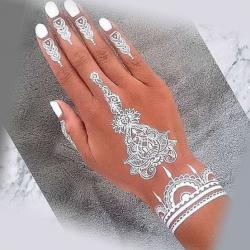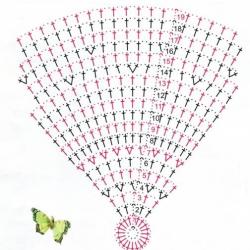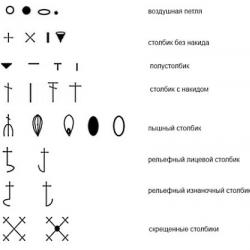Knitting double elastic pattern. Double-sided or double knitting. Hollow double elastic band
Double elastic is also called hollow. This elastic band is used for knitting the edges of products: hats, mittens, cuffs, panties, skirts, etc. This elastic band is a canvas folded in half. But in order not to knit a long fabric and stitch it manually to create a cavity, they use the double elastic knitting technique. It is convenient to insert a regular underwear elastic into such a cavity to tighten the knitting. Also, instead of inserting an elastic band, you can knit together with an elastic thread chosen to match the color of the yarn.
Before starting work, experiment, because... It may not work right away. We must not forget that to knit such an elastic band, twice as many loops are cast on the knitting needles. That is, if you need 20 loops for the main fabric of the product, then for the elastic you cast on 40. After that, you will see that the fabric itself will be made of 20 loops. It is desirable that the number of loops being cast on is even.
It is necessary to knit the first and second row correctly, so the fabric will be easier to knit.
So, we cast on 40 initial loops. We knit the first row like this: we remove the edge loop, 1 knit stitch, remove the next loop on another knitting needle, like a purl, and the working thread in front, then again 1 knit stitch, remove 1 loop.
So we continue to knit until the end of the row.
Important point: The working thread should always be between the knit stitch and the slip stitch. Otherwise, a hollow elastic band will not work. We knit the second row like this: we remove the edge loop, we remove the front loop of the previous row onto a knitting needle (working thread in front), we knit the removed loop of the previous row with a front loop. By knitting 11-12 rows, you will get a hollow elastic band.
If the hollow elastic band on the product is knitted after the main fabric of the product, then for this it is necessary to double the number of loops. There are two ways to add loops.
First: pull a new loop through one knitted loop.
Second way: After each knitted loop, yarn over. In the next row, the yarn over is knitted with a knit stitch.
This way the elastic is knitted to the width you need. Then, when moving to the main fabric, knit one row with knit stitches, while knitting two knit stitches together. If the elastic is at the end of the product and after knitting the main fabric, then the loops knitted together are closed.
If the elastic is on the belt, then when moving to knitting the elastic, the loops increase, and when moving to knitting the main fabric, they decrease. Next, the fabric is knitted again according to the pattern.
This is what a hollow elastic band looks like if you remove the knitting needles when knitting: 
A hat knitted with English elastic is very fashionable now! You probably know that chunky knitted hats, with or without a lapel, are very popular this year. A beanie hat knitted with English elastic is good because it stretches easily and fits any head size. The hat turns out to be voluminous and soft, the pattern looks good both on the front and on the inside. We present to your attention 5 options for hats knitted with an elastic band.


Let's start with the simplest version of a lovely hat, which can be knitted on English knitting needles or, as it is also called, patent elastic. The stocking cap is knitted on circular knitting needles, but you can also use regular stocking needles, and at the end carefully sew up the seam with a large needle and thread matching the color of the cap. A classic English elastic band looks like this:

Basic techniques for knitting with English rib (Fig. 1, Fig. 2).

The first version of the English gum. To understand the principle of knitting, you can first practice on a small fragment.

The second version of the English gum. Master class of a hat with one lapel.
A beanie hat can be made to any length using an English elastic band. If you need a hat without a hem, knit until the stitches decrease 19.5-20 cm. If you decide to make a hat with one hem, then until the loops decrease, knit 25 cm from the cast-on edge. And there is a third option - a double hem, this will be a Takkori hat. In this case, you need to knit 28-30 cm before decreasing. How interesting it is to make the top of the head will be discussed below.
Hat size 52-56 cm. To avoid bandaging the product, tie a 10/10 cm sample with an English elastic band. Measure how many stitches you get in 1 cm, multiply by the size of your head. This way you will determine the exact number of stitches in the cast-on row.

For a hat with one lapel, we took this Turkish yarn: Alize classic, wool with acrylic, 100 g/240 m. 1 skein is enough for the product. We knit in 1 thread, knitting needles 2.5 or 3 mm. Take circular knitting needles, but if you are comfortable with simple knitting needles, knit with two knitting needles; 35 cm long knitting needles are perfect. At the end of the work, make a seam at the back of the head. The same goes for snood: we knit it on two regular knitting needles, and at the end we sew it along the width.

Cast on 68 stitches + 1 stitch to join around. If you decide to knit a stocking cap on circular knitting needles: do not forget to mark the end of the row with a pin and when moving from the 1st row to the 2nd, so that there is no hole between the loops, do this: transfer the 1st stitch of the cast-on row to the right knitting needle , throw the last stitch on it from the right needle. Return the 1st stitch to the right sp. and tighten the main knitting thread. At our place now 68 p. Pattern repeat - 2 loops.
We start knitting the 1st row like this: yarn over the 1st loop and remove the yarn over together with the loop (see Fig. 1). Knit 1, double crochet again, knit 1, double crochet, and so on we knit. to the end of the river The last paragraph is persons. We hang a pin.
2nd r.: everything is the other way around: *p. with a double crochet we knit together with a purl (Fig. 2), to the front one we add a yarn over *, a stitch with a double crochet together with a purl, to the front one - a yarn over, repeat from * to * until the end of the p. At the end of the river - stitch with double crochet.
3rd row: yarn over the 1st stitch (tighter so that there are no holes), yarn over and knit together, yarn over and remove, yarn over and knit together. - and so on until the end of the river.
4th row: like 2nd.
5th p: like 3rd.
That is, the principle of knitting is as follows: in further rows we add a yarn over to a single knit stitch, and we knit a double crochet loop like 1. In even rows we knit a double crochet loop like a purl stitch, in odd rows we knit it like a knit stitch.

We tie it until the height of the hat is already 25-26 cm. Next we will make the crown.

If you want to make a double lapel, you need to continue knitting until it decreases so that the height is 28-30 cm.
Decreases.
1st r: we get rid of the yarn over the entire row: knits. knit with double crochet.
Next, 3 rows with a simple elastic band 1*1 p.
Next row: shorten the purl stitches (knit 2 together, knit 1, knit 2 together, knit 1 and so on until the end of the row).
Track. R. : 2 p. together, 2 p.
And at the end of knitting there should be 8 stitches left, cut the thread and pull it through the rest. n. Tighten the thread. Sew the seam at the back of the head.
On video: beanie hat with English elastic band:

Photo number 1. The beanie cap is not high.

Photo number 2. The beanie cap is high, with an elongated crown.
This beanie hat is made with a 1 to 1 elastic band, or an English elastic band. It is knitted from bulky yarn with circular knitting needles 5 mm thick. For a hat size 52-56 we cast on 82 loops. We knit to the crown (beginning of decreases) the length you need. There may be an option with one or two lapels, or without bending the bottom at all. Divide the entire number of stitches in half (82: 2 = 41 stitches), mark with pins or markers. We highlight the central 11 sts with markers on each of the two sides of the cap. We place markers before the 1st loop and after the last st of 11 sts on both sides.
An important point: if you don’t want the hat to be too low, make decreases in each row (photo number 1). If you want an elongated crown, make decreases through the row!
We make an elongated crown. Knitting in the round. First, we decrease before the first of eleven sts. (Move this first st. so that it is on top of the previous one each time, knit together). Then we knit up to the next marker (the next 11 sts) and again decrease at the beginning and at the end of these 11 sts. Next row: we knit without decreasing. Next row: again decreases at the beginning and at the end of 11 sts. Gradually, our loops decrease, but the central track remains unchanged. We tie until there are 11 stitches left on one side and the other. We close 2 together, 11 stitches remain.
We cut the thread, collect all the loops at one point and tighten them.
In the video: how to knit a hat with a 1x1 elastic band and make a beautiful crown:
A snood knitted with an English elastic band is perfect for such a hat. The size of the snood is 24/60 cm. We knit in the transverse direction, then sew the beginning and the closed edge. The knitting pattern is a little higher.

Hat with double elastic band - master class
An excellent hat will appeal to those who do not like large, voluminous hats. The hat is knitted at the beginning with double 1x1 rib, and the majority is made with semi-patent rib. A very successful combination: the initial elastic band looks neat and does not stretch, and the semi-patent elastic band gives the desired volume.

To work you will need:
- Drops Cloud yarn (alpaca and polyamide, 50 g / 80 m) - 1.5 skeins with pompom.
- Circular knitting needles 5 and 7 mm thick.
- Scissors.
The knitting density of the elastic band is 1x1 - 10/10 sts are equal to 15 sts/22 r. knitting needles 5 mm.
Semi-patent elastic - 10/10 p. equals 12 p./17 r. knitting needles 7 mm.

Cast on 56 stitches on 5 mm thick needles. and knit 20 rows in the round with a simple 1x1 rib. We reach 21 p.m. At 21 p.m. you need to fold the elastic band in half and knit it together with the 1st row, picking it up by the stitch of the cast-on (starting) edge. Here it is important to ensure that the product does not warp and not miss a single stitch from the initial row. Please note that there should be alternation: knit, purl. Don't get confused while typing.

The double elastic band will fit snugly to the head and will not stretch much.

This results in a neat bottom of the cap.

We made 21 rows.
In the 22nd row we change the knitting needles to 7 mm. and switch to semi-patent elastic. There is no need to add stitches, since we changed the knitting needles to larger ones and changed the pattern. We must knit 36 rubles with a semi-patent elastic band. The knitting pattern for semi-patent elastic looks like this:

English gum.

Semi-patent rubber band.
As you can see, semi-patent elastic is not much different from English elastic, except that if you look at the light, you will see more intertwined threads.
The semi-patent elastic band is knitted like this:
There should be an odd number of loops.
1st r.: 1 p., 1 knit., at the end of the r. - 1 purl.
2nd row: how the knitting looks (1 knit, 1 purl), at the end - 1 knit.
3rd r.: 1 p., 1 knit. (Insert a knitting needle into the stitch of the previous row and perform it knit.), at the end - 1 purl.
4th row: how the knitting looks (1 knit, 1 purl), at the end - 1 knit.
Repeat the 3rd and 4th rows.

This is what the rubber band looks like.

In the 37th row, knit a knit stitch and a purl stitch together, tilting to the left. There are 28 6 stitches left on the needles. In the 38th r. the whole river performed by persons. 2 p. together.

We tighten the last 14 stitches of the crown and secure the end of the thread inside the knitting.
That's all. Another master class on knitting hats has been completed.
Another option for knitting with an elastic band, similar to the English one, is a beanie hat with French elastic with knitting needles. There are so many options for all kinds of elastic bands, but faceted elastic bands still look more beautiful: for example, Polish, French.
For such a hat, size 54-56, made from DROPS LIMA yarn - 50 g/100 m (70% wool, 30% alpaca) you will need 2 skeins of yarn.
Knitting density: 22 p. / 30 r. correspond to 10/10 cm on 3.5 mm needles.
Knitting needles: simple knitting needles 2.5 mm. and 3.5 mm. The length of the knitting needles is 40 cm. You can knit in the round if that’s more convenient for you.
In order to find out how many sts we need to cast on, we knit a small fragment on 3.5 mm knitting needles.
The number of loops should be divided by 4, since we knit with a French elastic band, which has a repeat of 4 loops.
Our threads are thin, for knitting needles 2.5 mm. you need to dial 108 p. At the end of the work we will simply sew a hat on the back of the head.


We dialed on the knitting needles 2.5 mm. 108 sts and knit 3 cm with knit 1 rib. / 1 p. Next we switch to 3.5 mm knitting needles. and the French rib pattern.
1st row: k3, 1 p. remove on the right knitting needle, thread before work (see diagram), k3, k1, remove thread before work, k3, 1 p. remove, and so on until end of the row, last stitch - purl.
Turned the knitting over.
2nd r.: K1, 1 p. remove the thread before working, k3, k1, remove 1 p., k3, 1 p. remove, and so on until the end of the r. At the end, the last ones are 2 persons.
3rd row: like 1st,
4th row: like 2nd.
After 20 cm from the cast-on edge we begin decreasing. We will decrease through the row.
Decreases. We ended up with a pattern with elongated faces. P.
We need an odd r. We knit: knit 1, purl 2 together, purl 1, knit 1, purl 2 together, purl 1, knit 1, purl 2 together, purl 1, and so on until the end of the row.
Next row: no decreases.
Next row: k1, p2tog, k1, k2. purl and so on until the end of the river.
Track. r.: no decreases.
Next row: faces. knit together with purl. Only faces remain.
Let's see if we have already removed enough sts. If it is enough, then we collect all the sts in a pile and thread a thread through the sts and pull it tighter.



A stocking cap with 2x2 ribbed knitting needles is a great opportunity to knit a hat for yourself in 1 evening. Elastic band 2 by 2 - knits without problems, if you take thin knitting needles - the product will look like the store-bought version.
double or hollow elastic knitting
When knitting hollow or double rib in the round, it is very important to keep track of the even and odd rows. To make this task easier, mark the beginning of the row with a piece of bright thread, and then you will definitely not go astray from the pattern. The hollow elastic pattern when knitting in the round is slightly different from the same knitting pattern
1st row: knit with a 1x1 elastic band, that is, 1 knit stitch, 1 purl loop;
2nd row: 1 knit stitch is knitted, and 1 purl loop is removed, while the thread remains in front of the removed loop;
3rd row: 1 purl loop (which was removed in the previous row) is knitted, and 1 knit loop is removed, while the thread should be behind the loop, that is, the thread always remains inside the elastic cavity.
Next, repeat the hollow elastic knitting pattern from the 2nd row. So knit to the desired length.



To switch from double elastic to the main fabric, you need to halve the number of loops and switch to knitting needles of a larger diameter. To reduce the number of loops, knit a knit stitch and a purl stitch together.
If the double elastic band is a continuation of the main fabric, then the number of loops needs to be doubled. To do this, most often, 2 loops are knitted from each loop of the main fabric, switching to knitting needles of a smaller diameter.
Finishing a hollow rib when knitting in the round depends on the edge you want to achieve. If you need a fairly hard edge, the loops are closed in the usual way, but 2 loops at a time. That is, 1 loop is closed at the same time from each wall of the hollow elastic band.
To obtain an elastic edge, the loops are connected using a needle with a horizontal knitted seam.

elastic bands 2x2

elastic bands 2x2

elastic bands 1x1
For other types of rubber bands, see the section

Even experienced knitters do not always know how to correctly knit a pattern called “tubular elastic.” In practice, this simple and very popular knitting allows you to get a smooth fabric that looks like a seamless pipe.
Even the very concept of “tubular” is directly related to the word “tube” (tunnel, pipe), therefore it very succinctly and realistically characterizes the type of pattern. Its second name, more common, is "hollow rubber band" which, however, does not look like the usual “grooved” elastic band, but rather like stocking stitch.
You have probably seen such a hollow “pipe” many times; it is often used to make elements of knitted clothing - cuffs and collars for adult and children’s sweaters, trims, pocket flaps, belts and more.
Also, the principle of tubular knitting can be used in the manufacture of wide decorative laces. In addition, with the help of tubular elastic, you can reduce the number of loops when switching to knitting a cuff or any other tapering element from the main fabric.
How to knit double rib with knitting needles?
To the delight of novice needlewomen, knitting a double elastic band with knitting needles is not difficult: however, from the very beginning you need to control the number of loops on the knitting needle - it should be even, this is very important. To make the pattern look as aesthetically pleasing and neat as possible, it is recommended to cast on the stitches in the Italian way, in which they initially lie on the knitting needle as purl and knit stitches.
The standard pattern for knitting tubular elastic is simple:
- first we knit the first row according to the “1 by 1” pattern: the first loop is knitted as a knit stitch, the next one is removed as a purl stitch (we place the working thread in front of the left knitting needle and remove the loop), the third is knitted again, and so we knit all the loops of the row, alternating two steps ;
- Now let’s move on to the second row: the same techniques are used (knitting with a knit stitch + removing the loop following it as a purl), but this must be done in the reverse order - remove the purl loop over the knit loop of the first row, knit a knit loop over the removed loop, and so on to the end of the row.
Then we consistently adhere to the same pattern of knitting double elastic with knitting needles - we alternate rows (first-second, first-second) until our fabric reaches the required length. If we are talking about circular knitting, the pattern is slightly modified. The requirements for the number of loops remain the same; there must be an even number of them.
We knit the first row in the round in the same way as when knitting straight tubular elastic, and then distribute the second row over different knitting needles.
To do this, we place the finished, fully knitted first row on two knitting needles (on one - knit stitches, on the second - removed stitches).
Of course, you can use one ball, but in this case you will have to use pairs of knitting needles alternately, otherwise you will not be able to make a through hole for inserting an elastic band. Each master chooses the most comfortable method of work for himself. One important nuance should be taken into account: when making such a pattern, the thread consumption is greater than with regular knitting, so buy balls “with a reserve”.

Knitted double elastic band on knitting needles is also called hollow, since it is a double fabric connected only at the edges. Double elastic is good for knitting a belt, as you can insert an elastic band or lace into it. The double ribbing fabric looks the same on the front and back sides, like a straight stocking stitch, and due to the double thickness it turns out thicker and warmer. With a double elastic band you can knit warm two-layer items - hats, scarves, mittens.
Learn how to knit double elastic with knitting needles in this master class with detailed photos.
To start knitting a double elastic band, cast on loops, doubling their number. Please note that by knitting several rows, the initial row will shrink in half. First knit a small sample and use it to determine the required number of stitches to cast on. 
When knitting straight fabric, the knit and purl rows of double rib are knitted the same way.
In the first row, repeat: knit 1 stitch, slip the next stitch, placing the working thread in front of the loop. Having knitted the row to the end, turn the work. 

In the second row, alternate the other way around: knit the loop that was removed in the previous row, and remove the next one, placing the working thread in front of the work. By knitting two rows, the fabric will increase in height by only one row. 


Next, knit a double elastic band, repeating these two steps:
Knit the loop removed in the previous row, remove the next loop, placing the working thread forward.
Accordingly, if you have an even number of rows and the row begins with knitting a knit stitch and ends with slipping off the last loop without knitting, then in the next row knit the first loop with a knit stitch, and the last one should also be removed unknitted. 


Having knitted several rows of double elastic, you can clearly see the loops of the front fabric that need to be knitted in this row and the loops of the rear fabric, which can be removed without knitting by moving the working thread forward. The front and back sides are practically indistinguishable, only the initial row on the wrong side looks different. 
If you separate the stitches and slip them onto two needles, you will see two layers of stockinette stitch, wrong side in, connected by the starting row and the edges.
Having knitted a double elastic band to the required height, in the last row knit 2 loops together with the front one to switch to regular knitting. 
When knitting hats and cuffs, double rib can be knitted in the round on stocking or circular knitting needles. To start knitting, also cast on twice the number of loops and close them into a ring. 
When knitting in the round, the loops are knitted only on the front side, but since it is necessary to knit the first and second layers of double elastic in height, we will alternate the front and back rows. It is necessary to mark the beginning of the rows to make the transition.
In the front row we knit the loops of the front fabric, and remove the purl ones, and in the next purl row we knit the loops of the wrong side, and remove them from the front without knitting.
So, first row (front row), repeat until the end of the row:
Knit 1 stitch, slip the next stitch, placing the working thread in front of the loop. 

Second (purl) row:
Remove the 1st loop, placing the working thread behind the loop, knit the next loop purl. 

Knit a double elastic band in height in the round, repeating the 1st and 2nd row. 
If you remove the loops from the knitting needles, the double elastic band will separate into two layers. When knitting a double elastic band, the yarn consumption is double. 






